Do you have a question about the Roland V-Drums TD-20 and is the answer not in the manual?
Guidelines for safe and proper power supply usage to prevent malfunctions.
Recommendations for unit placement to ensure optimal performance and avoid damage.
Instructions for cleaning the unit safely using appropriate materials.
Information on data loss during repairs and the importance of backup.
Details on the unit's backup battery and its replacement procedure.
Precautions and steps for inserting and handling data cards.
Overview of advancements in the TD-20's core components and V-Hi-Hat.
Details on the TD-20's sound library and V-Editing capabilities for sound customization.
Explanation of the easy-to-navigate interface and high-speed triggering technology.
Information on CompactFlash data management and flexible audio output routing.
Features of the VH-12 V-Hi-Hat and ease of cable organization with the stand.
Details on individual and master EQ, compressor, and multi-effects.
Using group faders, chains, and other features for live performance.
Basic functions for recording and playback of patterns.
Tempo settings, expansion board, MIDI potentials, and V-LINK function.
Overview of the TD-20's top panel controls, indicators, and displays.
Description of the TD-20's rear panel jacks and switches.
Details on the TD-20's front panel jacks and CompactFlash slot.
Instructions for attaching the TD-20 unit to a drum stand securely.
Guide to connecting all drum pads, cymbals, and pedals to the TD-20.
How to connect external audio sources and headphones to the TD-20.
Procedures for safely powering the TD-20 and connected devices on and off.
Connecting the VH-12 hi-hat and setting its offset for proper triggering.
Guide to tuning drum pads for optimal triggering performance.
How the TD-20 automatically stores changes to memory.
Explanation of buttons, sliders, dial, and knobs for unit operation.
How to use the cursor to move between on-screen parameters.
Explanation of the F1-F5 buttons and their context-sensitive functions.
Methods for adjusting settings using +/- buttons or the VALUE dial.
How to use group faders to adjust sound volumes and mixer settings.
Using trigger select buttons to choose pads for editing.
Steps to select, play, and stop patterns from the sequencer.
How to control the metronome and adjust the tempo.
Adjusting display contrast and understanding screen information.
Information about the factory-loaded drum kits.
How to play different sounds using the PD pads, including rim shots.
Techniques for playing the VH-12 hi-hat, including open/closed and pressure.
Playing techniques for cymbals like bow, edge, bell shots, and choke.
How to choose, view, and select drum kits from the TD-20.
Adjusting kit volume, tempo, brush sounds, and output levels.
How to name drum kits and enable or disable the cross stick function.
Methods to select pads for editing via striking or trigger select buttons.
How to select and assign sounds (instruments) to drum pads.
Browsing and choosing instruments from the TD-20's library.
Advanced editing for acoustic drum sounds and other instruments.
Detailed parameters for editing kick drum sounds.
Detailed parameters for editing snare drum sounds.
Detailed parameters for editing tom drum sounds.
Detailed parameters for editing hi-hat sounds.
Parameters for editing cymbal, splash, china, and ride sounds.
Editing parameters for miscellaneous instruments.
Utilizing pads and pedals for pattern playback and pitch bending.
Configuring MIDI settings for pads, hi-hat, and brush/cross stick.
Adjusting volume, pan, and minimum volume for each trigger input.
Using group faders to adjust mixer parameters quickly.
Turning individual and master effects on or off within drum kits.
Applying compressor and equalizer effects to individual sounds.
Detailed parameters for the compressor effect.
Detailed parameters for the equalizer effect.
Adjusting room type, size, and send levels for ambience effects.
Applying and adjusting multi-effects to sounds.
Details on Reverb, Gate Reverb, Delay, Panning Delay, and Beat Delay.
Details on Flanger, Phaser, Chorus, Enhancer, Pitch Shift, Overdrive, Distortion.
Details on Lo-Fi, Ring Mod, and Master Effects (COMP/EQ).
Applying master compression and equalization to the overall sound.
Choosing the correct pad type for each trigger input for optimal performance.
Mapping trigger inputs to pad types and playing methods.
Adjusting pad sensitivity, threshold, and velocity curve for playing dynamics.
Configuring hi-hat controller settings, including offset and noise cancel.
Reducing unintended pad triggering caused by crosstalk.
Fine-tuning scan time, retrigger cancel, and double triggering prevention.
Adjusting rim/edge response, rim shot response, and cross stick threshold.
Using bow, bell, and edge triggering for ride cymbals.
Naming trigger banks for better organization and recall.
Overview of the TD-20's sequencer and pattern structure.
Information on pre-loaded patterns and using custom patterns.
Steps to select, play, and stop patterns, including list view.
Setting tempo via tap tempo and synchronizing with external MIDI devices.
Muting specific parts and configuring backing parts for patterns.
Adjusting overall tuning and understanding instrument numbering.
Selecting, setting, and naming percussion sets with instruments.
Setting pattern time signature, measures, tempo, and playback type.
Naming patterns and controlling the metronome click.
Configuring click sound settings, including instrument and output destination.
Steps for recording patterns in realtime, including selecting empty patterns.
Setting time signature, measures, tempo, MIDI channel, and part settings.
Choosing recording modes, quantizing, and using rehearsal.
Editing existing patterns and copying patterns or measures.
Connecting two patterns and erasing entire patterns or selected measures.
Removing patterns and measures, creating empty patterns.
Saving pattern data to a CompactFlash card.
Loading and removing pattern data from a CompactFlash card.
Saving all TD-20 data, including kits and patterns, to a CompactFlash card.
Naming backup data and loading data from a CompactFlash card.
Removing data from and initializing CompactFlash cards.
Viewing information about the CompactFlash card's usage and capacity.
Configuring MIDI channels, global settings, and detailed performance messages.
Managing internal/external sound triggering and setting device IDs.
Setting MIDI channels and device IDs for V-LINK control.
Mapping MIDI control messages and switching kits via program changes.
Saving data via bulk dump and loading data from external MIDI devices.
Assigning trigger inputs, sequencer parts, and MIX IN to output jacks.
Setting up foot switches, pads as switches, and other options.
Selecting master effect mode and adjusting display contrast.
Resetting the TD-20 to its original factory default configuration.
Steps to create, store, and name sequences of drum kits.
How to play through a created drum kit chain using the unit or switches.
Checking the output levels of master, phones, and direct outputs.
Viewing internal memory, card, and version information.
Explanation of V-LINK for visual control and connection examples.
Turning V-LINK on/off and controlling video via MIDI messages.
Safety precautions for handling and installing expansion boards.
Step-by-step guide for installing an expansion board into the TD-20.
List of error messages, their meanings, and recommended actions.
List of system messages, their meanings, and recommended actions.
Explanations of symbols like P (Position) and I (Interval) in instrument names.
How instrument names indicate head or rim sounds for snares and toms.
How instrument names indicate bow, edge, or bell sounds for cymbals.
Legal information regarding the use of included sounds.
List of note numbers and instruments for percussion sets.
Mapping of trigger inputs to note numbers for drum kits.
Details on the TD-20's sound engine and voice capacity.
Counts for drum instruments, backing instruments, drum kits, and chains.
List of editable parameters for instruments and available effects.
Specifications for ambience, mixer, and percussion set features.
Details on the sequencer, display, faders, and preview button.
Details on connectors, power, dimensions, weight, and optional accessories.
Guidelines for safe and proper power supply usage to prevent malfunctions.
Recommendations for unit placement to ensure optimal performance and avoid damage.
Instructions for cleaning the unit safely using appropriate materials.
Information on data loss during repairs and the importance of backup.
Details on the unit's backup battery and its replacement procedure.
Precautions and steps for inserting and handling data cards.
Overview of advancements in the TD-20's core components and V-Hi-Hat.
Details on the TD-20's sound library and V-Editing capabilities for sound customization.
Explanation of the easy-to-navigate interface and high-speed triggering technology.
Information on CompactFlash data management and flexible audio output routing.
Features of the VH-12 V-Hi-Hat and ease of cable organization with the stand.
Details on individual and master EQ, compressor, and multi-effects.
Using group faders, chains, and other features for live performance.
Basic functions for recording and playback of patterns.
Tempo settings, expansion board, MIDI potentials, and V-LINK function.
Overview of the TD-20's top panel controls, indicators, and displays.
Description of the TD-20's rear panel jacks and switches.
Details on the TD-20's front panel jacks and CompactFlash slot.
Instructions for attaching the TD-20 unit to a drum stand securely.
Guide to connecting all drum pads, cymbals, and pedals to the TD-20.
How to connect external audio sources and headphones to the TD-20.
Procedures for safely powering the TD-20 and connected devices on and off.
Connecting the VH-12 hi-hat and setting its offset for proper triggering.
Guide to tuning drum pads for optimal triggering performance.
How the TD-20 automatically stores changes to memory.
Explanation of buttons, sliders, dial, and knobs for unit operation.
How to use the cursor to move between on-screen parameters.
Explanation of the F1-F5 buttons and their context-sensitive functions.
Methods for adjusting settings using +/- buttons or the VALUE dial.
How to use group faders to adjust sound volumes and mixer settings.
Using trigger select buttons to choose pads for editing.
Steps to select, play, and stop patterns from the sequencer.
How to control the metronome and adjust the tempo.
Adjusting display contrast and understanding screen information.
Information about the factory-loaded drum kits.
How to play different sounds using the PD pads, including rim shots.
Techniques for playing the VH-12 hi-hat, including open/closed and pressure.
Playing techniques for cymbals like bow, edge, bell shots, and choke.
How to choose, view, and select drum kits from the TD-20.
Adjusting kit volume, tempo, brush sounds, and output levels.
How to name drum kits and enable or disable the cross stick function.
Methods to select pads for editing via striking or trigger select buttons.
How to select and assign sounds (instruments) to drum pads.
Browsing and choosing instruments from the TD-20's library.
Advanced editing for acoustic drum sounds and other instruments.
Detailed parameters for editing kick drum sounds.
Detailed parameters for editing snare drum sounds.
Detailed parameters for editing tom drum sounds.
Detailed parameters for editing hi-hat sounds.
Parameters for editing cymbal, splash, china, and ride sounds.
Editing parameters for miscellaneous instruments.
Utilizing pads and pedals for pattern playback and pitch bending.
Configuring MIDI settings for pads, hi-hat, and brush/cross stick.
Adjusting volume, pan, and minimum volume for each trigger input.
Using group faders to adjust mixer parameters quickly.
Turning individual and master effects on or off within drum kits.
Applying compressor and equalizer effects to individual sounds.
Detailed parameters for the compressor effect.
Detailed parameters for the equalizer effect.
Adjusting room type, size, and send levels for ambience effects.
Applying and adjusting multi-effects to sounds.
Details on Reverb, Gate Reverb, Delay, Panning Delay, and Beat Delay.
Details on Flanger, Phaser, Chorus, Enhancer, Pitch Shift, Overdrive, Distortion.
Details on Lo-Fi, Ring Mod, and Master Effects (COMP/EQ).
Applying master compression and equalization to the overall sound.
Choosing the correct pad type for each trigger input for optimal performance.
Mapping trigger inputs to pad types and playing methods.
Adjusting pad sensitivity, threshold, and velocity curve for playing dynamics.
Configuring hi-hat controller settings, including offset and noise cancel.
Reducing unintended pad triggering caused by crosstalk.
Fine-tuning scan time, retrigger cancel, and double triggering prevention.
Adjusting rim/edge response, rim shot response, and cross stick threshold.
Using bow, bell, and edge triggering for ride cymbals.
Naming trigger banks for better organization and recall.
Overview of the TD-20's sequencer and pattern structure.
Information on pre-loaded patterns and using custom patterns.
Steps to select, play, and stop patterns, including list view.
Setting tempo via tap tempo and synchronizing with external MIDI devices.
Muting specific parts and configuring backing parts for patterns.
Adjusting overall tuning and understanding instrument numbering.
Selecting, setting, and naming percussion sets with instruments.
Setting pattern time signature, measures, tempo, and playback type.
Naming patterns and controlling the metronome click.
Configuring click sound settings, including instrument and output destination.
Steps for recording patterns in realtime, including selecting empty patterns.
Setting time signature, measures, tempo, MIDI channel, and part settings.
Choosing recording modes, quantizing, and using rehearsal.
Editing existing patterns and copying patterns or measures.
Connecting two patterns and erasing entire patterns or selected measures.
Removing patterns and measures, creating empty patterns.
Saving pattern data to a CompactFlash card.
Loading and removing pattern data from a CompactFlash card.
Saving all TD-20 data, including kits and patterns, to a CompactFlash card.
Naming backup data and loading data from a CompactFlash card.
Removing data from and initializing CompactFlash cards.
Viewing information about the CompactFlash card's usage and capacity.
Configuring MIDI channels, global settings, and detailed performance messages.
Managing internal/external sound triggering and setting device IDs.
Setting MIDI channels and device IDs for V-LINK control.
Mapping MIDI control messages and switching kits via program changes.
Saving data via bulk dump and loading data from external MIDI devices.
Assigning trigger inputs, sequencer parts, and MIX IN to output jacks.
Setting up foot switches, pads as switches, and other options.
Selecting master effect mode and adjusting display contrast.
Resetting the TD-20 to its original factory default configuration.
Steps to create, store, and name sequences of drum kits.
How to play through a created drum kit chain using the unit or switches.
Checking the output levels of master, phones, and direct outputs.
Viewing internal memory, card, and version information.
Explanation of V-LINK for visual control and connection examples.
Turning V-LINK on/off and controlling video via MIDI messages.
Safety precautions for handling and installing expansion boards.
Step-by-step guide for installing an expansion board into the TD-20.
List of error messages, their meanings, and recommended actions.
List of system messages, their meanings, and recommended actions.
Explanations of symbols like P (Position) and I (Interval) in instrument names.
How instrument names indicate head or rim sounds for snares and toms.
How instrument names indicate bow, edge, or bell sounds for cymbals.
Legal information regarding the use of included sounds.
List of note numbers and instruments for percussion sets.
Mapping of trigger inputs to note numbers for drum kits.
Details on the TD-20's sound engine and voice capacity.
Counts for drum instruments, backing instruments, drum kits, and chains.
List of editable parameters for instruments and available effects.
Specifications for ambience, mixer, and percussion set features.
Details on the sequencer, display, faders, and preview button.
Details on connectors, power, dimensions, weight, and optional accessories.
| Sound Module | TD-20 |
|---|---|
| Trigger Inputs | 12 |
| Effects | Compressor |
| MIDI | In, Out, Thru |
| Connectivity | MIDI |
| Display | 64 x 240 dots graphic LCD (with backlight) |
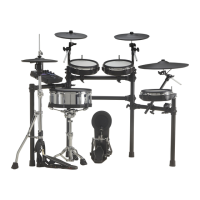
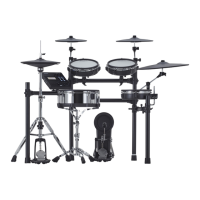

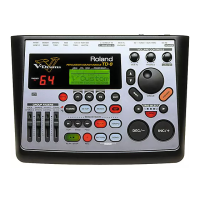
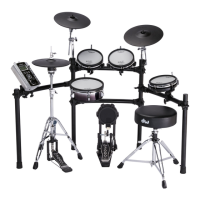
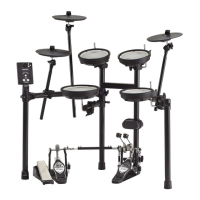
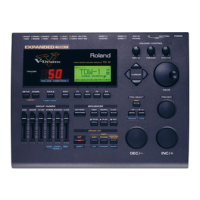
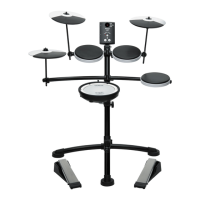
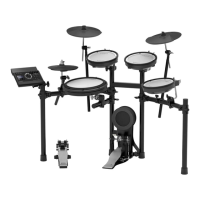
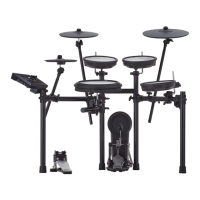
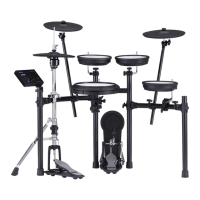
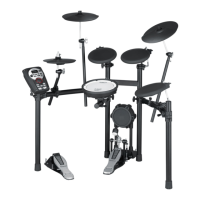
